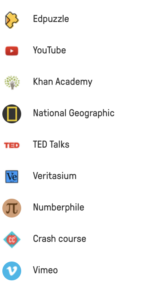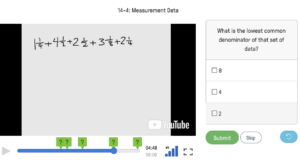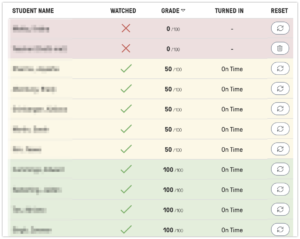Now that I am in the 4th quarter of my third year back in the classroom, I have finally evolved a general lesson structure that is working well. The next few blog posts with explain the typical parts of my math lessons.
The lesson begins the night before. I flip my initial instruction by using the free, ad-free website EdPuzzle. This site allows me to embed quizzes into tutorials. There is a bank of videos made by other teachers which is accessible in EdPuzzle. The site also allows you to search other sites, such as Khan Academy and YouTube.

However, if you import from other sites, you need to embed your own quizzes. I make my quizzes multiple choice. If I construct them well, I get useful information from which incorrect answers a child chooses. I also choose multiple choice so that students get immediate feedback. Brain research shows that optimal learning comes when feedback is received within 20 minutes of completing an assignment.
Students watch the video at home, or in class if they finished the previous day’s assignments before the end of class. There is a setting which makes it impossible for students to skip the video and just jump to each of the questions. Of course, a child who really doesn’t want to take part will just not listen, but that happens during live lectures also.

I instruct students that they must work along with the video on a whiteboard or on paper. I am certain that many of them do not do that. I could require them to write it on paper and turn it in. That is a logical next step.
After students complete the video, my dashboard shows the results in a color-coded list, with the lowest scores at the top.

I can drill down into the student level to see which problems they had incorrect, and how they answered. I use this information to adjust the next day’s lesson. Usually my assistant and I use it to know who to check in, or even sit with during the guided instruction.
A number of factors motivated me to flip my math instruction. By fifth grade, most of my students don’t have someone at home helping them with homework. That can make homework frustrating, or detrimental if they work all of the problems incorrectly.
Another problem is the time it took in class to correct the homework, but that wasn’t time well spent. I didn’t have time to use the data to address misconceptions, and the corrections are coming too late to make much impact on student learning.
Finally, since homework is not included in their grade, many children are more motivated to get it done than get it correct. All-in-all, it wasn’t working. It is a lot of working getting this set up for every lesson, but I am pleased with how it working.
I have only one problem with this website. It currently has a few bugs which occasionally cause some of the quizzes to skip or not display all of the information. They are working to solve this bug.
